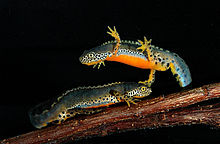| Alpine newt Temporal range:
| |
|---|---|

| |
| Two males during breeding season | |
| Scientific classification | |
| Domain: | Eukaryota |
| Kingdom: | Animalia |
| Phylum: | Chordata |
| Class: | Amphibia |
| Order: | Urodela |
| Family: | Salamandridae |
| Genus: | Ichthyosaura Latreille, 1801 |
| Species: | I. alpestris
|
| Binomial name | |
| Ichthyosaura alpestris (Laurenti, 1768)
| |
| Subspecies | |
(debated, see text) | |

| |
| Synonyms | |
|
Around 80,[3] including:
| |
The alpine newt (Ichthyosaura alpestris) is a species of newt native to continental Europe and introduced to Great Britain and New Zealand. Adults measure 7–12 cm (2.8–4.7 in) and are usually dark grey to blue on the back and sides, with an orange belly and throat. Males are more conspicuously coloured than the drab females, especially during breeding season.
The alpine newt occurs at high altitude as well as in the lowlands. Living mainly in forested land habitats for most of the year, the adults migrate to puddles, ponds, lakes or similar water bodies for breeding. Males court females with a ritualised display and deposit a spermatophore. After fertilisation, females usually fold their eggs into leaves of water plants. The aquatic larvae grow up to 5 cm (2.0 in) in around three months before metamorphosing into terrestrial juvenile efts, which mature into adults at around three years. In the southern range, the newts sometimes do not metamorphose but keep their gills and stay aquatic as paedomorphic adults. Larvae and adults feed mainly on diverse invertebrates and themselves fall prey to dragonfly larvae, large beetles, fish, snakes, birds or mammals.
Populations of the alpine newt started to diverge around 20 million years ago. At least four subspecies are distinguished, and some argue there are several distinct, cryptic species. Although still relatively common and classified as Least Concern on the IUCN Red List, alpine newt populations are decreasing and have locally gone extinct. The main threats are habitat destruction, pollution and the introduction of fish such as trout into breeding sites. Where it has been introduced, the alpine newt can potentially transmit diseases to native amphibians, and it is being eradicated in New Zealand.
